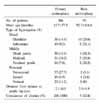Abstract
Purpose
We retrospectively evaluated the outcome and risk factors of tubularized incised plate (TIP) urethroplasty in patients with reoperative hypospadias repairs.
Materials and Methods
Thirty-nine patients with reoperative hypospadias repairs by the TIP method were evaluated. The meatal location, interval between prior urethroplasty and reoperation, length from meatus to penile tip, coexistence of chordee, type of prior urethroplasty, shape of glans, scarring on urethral plate, times of prior urethroplasty, and complications were reviewed. We also evaluated the outcome of reoperative hypospadias repairs and the relationships between these factors and outcomes.
Results
The mean age of the patients was 47.7±77.9 months (range: 5-384 months) at prior urethroplasty and 92.7±115.6 months (12-480 months) at reoperative urethroplasty, and the mean follow-up duration was 54.2±90.5 months (6-443 months). Complications at prior urethroplasty included urethrocutaneous fistula in 18 patients, wound dehiscence in 9, meatal stenosis in 5, persistent chordee in 5, and urethral diverticulum in 3. Complications at TIP reoperation were urethrocutaneous fistula and wound dehiscence in 11 and 4 patients, respectively (complication rate: 38.5%). Older age at the time of the repeat urethroplasty, long urethral defect, and scarring in the urethral plate at reoperation were related with poor outcomes in reoperative urethroplasty.
References
1. Sweet RA, Schrott HG, Kurland R, Culp OS. Study of the incidence of hypospadias in Rochester, Minnesota, 1940-1970, and a case-control comparison of possible etiologic factors. Mayo Clin Proc. 1974. 49:52–58.
2. Snodgrass W. Tubularized, incised plate urethroplasty for distal hypospadias. J Urol. 1994. 151:464–465.
3. Snodgrass W, Koyle M, Manzoni G, Hurwitz R, Caldamone A, Ehrlich R. Tubularized incised plate hypospadias repair for proximal hypospadias. J Urol. 1998. 159:2129–2131.
4. Mouriquand P, Mure PY, Zeidan S, Gelas T. Hadidi AT, Azmy AF, editors. Management of failed hypospadias repairs. Hypospadias surgery. 2004. 1st ed. New York: Springer;305–311.
5. Hayashi Y, Kojima Y, Mizuno K, Nakane A, Tozawa K, Sasaki S, et al. Tubularized incised plate urethroplasty for secondary hypospadias surgery. Int J Urol. 2001. 8:444–448.
6. Lee HC, Moon HS, Shin KY, Woo YN. Experience of redo urethroplasty for complicated recurrent hypospadias. Korean J Urol. 1999. 40:1367–1370.
7. Luo CC, Lin JN. Repair of hypospadias complications using the tubularized, incised plate urethroplasty. J Pediatr Surg. 1999. 34:1665–1667.
8. Horton CE Jr, Horton CE. Complications of hypospadias surgery. Clin Plast Surg. 1988. 15:371–379.
9. Duckett JW. Advances in hypospadias repair. Postgrad Med J. 1990. 66:Suppl 1. S62–S71.
10. Snodgrass W, Koyle M, Manzoni G, Hurwitz R, Caldamone A, Ehrlich R. Tubularized incised plate hypospadias repair: results of a multicenter experience. J Urol. 1996. 156:839–841.
11. Hwang JS, Jung GW, Cho WY. A study of tubularized incised plate urethroplasty for correction of hypospadias. Korean J Urol. 2003. 44:1026–1031.
12. Seo JH, Seo YJ, Chung SK. Surgical correction of hypospadias using tubularized incised plate urethroplasty. Korean J Urol. 2002. 43:858–861.
13. Nguyen MT, Snodgrass WT. Tubularized incised plate hypospadias reoperation. J Urol. 2004. 171:2404–2406.
14. Hyun JH, Shin JS, Park KH. Comparison of the surgical outcome between onlay island flap and tubularized incised plate urethroplasty in hypospadias repair. Korean J Urol. 2004. 45:573–577.
15. Erol A, Baskin LS, Li YW, Liu WH. Anatomical studies of the urethral plate: why preservation of the urethral plate is important in hypospadias repair. BJU Int. 2000. 85:728–734.
16. Senkul T, Karademir K, Iseri C, Erden D, Baykal K, Adayener C. Hypospadias in adults. Urology. 2002. 60:1059–1062.
17. Yang SS, Chen SC, Hsieh CH, Chen YT. Reoperative Snodgrass procedure. J Urol. 2001. 166:2342–2345.
18. Lee W, Shin DG, Lee SD. Outcome of tubularized incised plate urethroplasty for hypospadias reoperation. Korean J Urol. 2003. 44:233–237.




 PDF
PDF ePub
ePub Citation
Citation Print
Print





 XML Download
XML Download